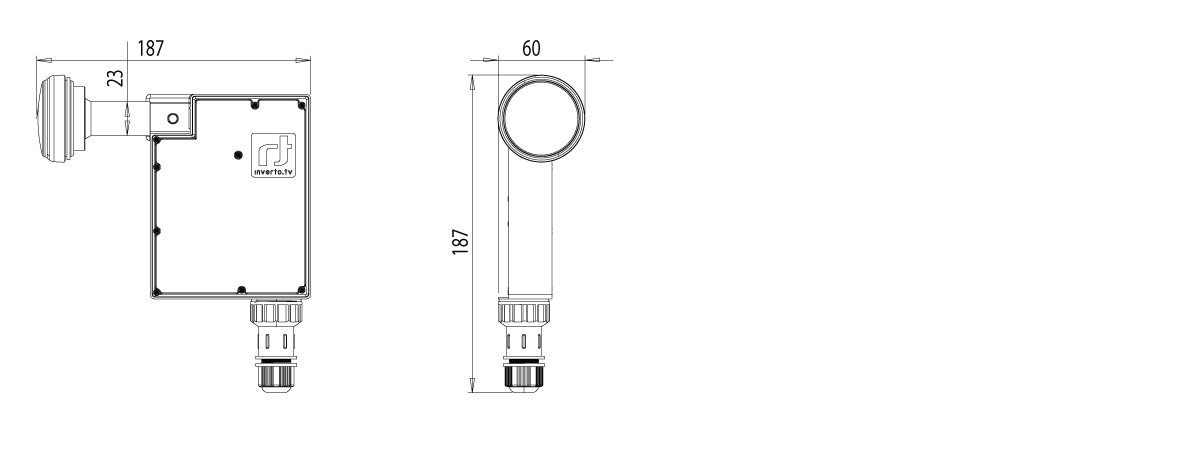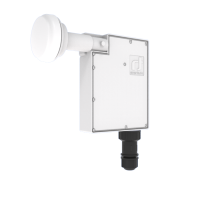Inverto’s iLNB™ delivers satellite broadcast content to Smart TVs, Tablets, Smartphones and PCs connected to the home IP network The iLNB can receive up to eight different transponders of a satellite orbital position. It allows up to eight SAT>IP compatible Client devices/apps to receive their selected TV program concurrently. The iLNB can also operate as an IPTV multicast server allowing selected TV programs to be distributed as IP multicast streams over a local area network.
The iLNB digitally samples the satellite signals directly at the antenna and makes the satellite spectrum data and other link quality metrics accessible over the home network. TV Programs can be streamed to fixed and/or portable SAT>IP compatible screens, devices or apps such as SmartTVs, STBs, PCs, Tablets and Smartphones that are connected over the same home network. Where a record function exists in the Client device [such as tablets] then the user has the added ability to record the program and watch off line at a later time.
The iLNB can connect to your home network WLAN router via a direct Ethernet connection or over power-line communication (PLC) adapters and can be used for free-to-air (FTA) or pay TV services.
Key features:
- Universal Ku-band frequency range 10.7-12.75GHz
- Reception of up to 8 DVB-S/S2 transponders
- Compliant with the SAT>IP communication protocol
- Operating modes: Unicast or Multicast
- Supporting up to 8 different SAT>IP -compatible Client devices/apps
- Web-based management interface
- Software upgradable online or through a local PC
- Power-over-Ethernet Type I, less than 10W for 8-channel operation
| Technical specifications | |
|---|---|
| IF frequency range |
950 MHz - 1950 MHz (low band) 1100 MHz - 2150 MHz (high band) |
| Low band input frequency range | 10.70 GHz ~ 11.70 GHz |
| Low band LO frequency |
9.75 GHz |
| High band input frequency range |
11.7 0 GHz ~ 12.75 GHz |
| High band LO frequency |
10.6 GHz |
| Noise figure |
1.3 dB max. |
| LO temperature drift | ± 5.5 MHz max. |
| LO initial accuracy | ± 2.0 MHz max. |
| Aggregated phase noise |
2.50 RMS (3 kHz ~ 15 MHz) |
| LO phase noise @ 1 kHz | -50 dBc/Hz |
| LO phase noise @ 10 kHz |
-75 dBc/Hz |
| LO phase noise @ 100 kHz | -95 dBc/Hz |
| LO phase noise @ 1 MHz | -105 dBc / Hz max. |
| Conversion gain |
40 dB ~ 50 dB |
| Gain ripple (over 26 MHz bandwidth) | 3 dB |
| Gain variation (over full band) | 6 dB |
| Image rejection |
40 dB min. |
| Cross polarization isolation | 22 dB typ. |
| Input VSWR |
2.5 : 1 |
| Operating temperature |
40˚ C ~ +65˚ C |
| Power supply |
48 V ±10% |
| Power consumption |
9 W typ, (12.95 W max.) |
| IP protection |
IP54 |
| Dish F/D ratio | 0.6 |
| Weight | 500 g |
| Remraks | LO inter modulation level -55 dBm max. |
| Logistical info | |
| Packaging dimensions (W x D x H) | 6,8 cm x 31,5 cm x 19,7 cm |
| Packaging weight | 0,79 kg |
| Quantity per Carton | 10 pcs |
| Carton dimensions (W x D x H) | 37 cm x 33,5 cm x 43 cm |
| Carton weight | 8.5 kg |
| Quantity per pallet | 450 pcs |


Installation guide

Images

Drawings

FAQ
Q: What is an LNB?
A:
An LNB - Low Noise Block (also called an LNC- Low Noise Converter), it is used for communications (broadcast) satellite reception. The LNB is usually affixed either in or on the satellite dish and its purpose is to collect and amplify the satellite signal received from the dish and then down convert the signal to lower more manageable IF frequency which can then be carried over standard coaxial cabling to the receiver.
Q: What is a feedhorn?
A:
The feedhorn is a part of the LNB and works like a directional horn. Its function is to capture the signals reflected from the dish and to shield the LNB from receiving extraneous radiation from other sources. These collected signals are then passed form the horn to the electronics within the LNB.
Q: What is the difference between a Quad and Quattro LNB?
A:
A quad or quad switch LNB is an LNB where the multi switch is integrated into the LNB and gives 4 independent output ports for the connection of 4 receivers. A Quattro LNB has 4 outputs and each of the output’s is set to one of the differing polarities, the 4 outputs are V/L, V/H, H/L & H/H. A Quattro LNB is normally used to feed a multiswitch which then allows the distribution of the signal to any number of satellite receivers. All four outputs of a Quattro LNB are marked accordingly with V/L, V/H, H/L & H/H to avoid confusion and malfunctions when connecting to the multiswitch.
Q: What is the HsQuare Technology?
A:
HsQuare is a unique waveguide technology which may be coupled with a slightly larger feed horn design to deliver better RF performances compared with common circular microwave waveguides.
Q: What is a monoblock LNB?
A:
This design consists of two independent LNBs in a single housing and allows a user the potential of receiving the signal from two different satellites which are at slightly different orbital opposition from a single dish installation. The switching between the satellitesis achieved via the use of DiSEqC signals or Toneburst (Mini DiSEqC). Monoblock LNB’s are available mostly for satellites with a fixed 4.3° or 6° spacing and the range covers Ku band monoblock switch single, twin and quad outputs.
Example where a 6° monoblock LNB could be used is for the reception of ASTRA 1 (19.2° East) and Hotbird (13° East) or with 4.3° distance for the reception of ASTRA 1 (19.2° East) and ASTRA 3 (23.5° East).
Q: Why can I receive only one satellite with my monoblock LNB?
A:
For dual satellite reception the dish is normally initially aligned to the weaker of the two satellites and then some slight adjustment can be made ensure the best possible reception from both the satellites. A monoblock installation will require a slightly larger dish size than if only one satellite location had been chosen. Monoblock LNBs are designed to work on a specific dish size and it’s important that the correct dish size is installed or both satellites signals may not be picked up at a sufficient level of strength to guarantee reliable reception.
Q: What is a wideband LNB?
A:
With a wideband LNB having only one local oscillator (e.g. 10.4GHz), and captures the full frequency spectrum of the satellite (300MHz to 2350MHz) which are delivered over two outputs from the LNB. One output carries all the vertically polarized signals whilst the second output carries all the horizontally polarized outputs. Whilst most of the current multiswitches on the market do not accept a wideband input the newer multiswitches such as newer Unicable switches are capable of accepting this as their input.
Caution: Wideband LNBs are not conventional twin LNBs. Wideband LNBs can be connected to a Unicable multiswitches that is designed for this purpose, or, if connected directly to a receiver, only with a suitable tuner.
Q: What does Unicable mean?
A:
Unicable is a new method for distributing satellite television. Several receivers (currently up to 32 in accordance with standard EN 50607) can be connected to only one single chain which is not possible with a conventional satellite distribution (star distribution in multi-switch mode). For more information about Unicable, see www.inverto.tv/what-is-unicable-2


